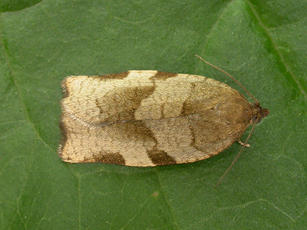Choristoneura hebenstreitella
Great Twist
Wingspan.20 to 30 mm. This rather large Tortrix is fairly distinctive. There is slight sexual dimorphism, females being generally larger than males.
Various habitats.
June and July is the flight period for the adult moths, which are on the wing around dusk.
The larvae feed on a wide range of deciduous trees and other plants, for example oak, birch and willow as well as on lower-growing plants including bilberry and ivy generally in rolled or spun leaves.
Distributed widely though locally throughout England and Wales, and commonest in the south. In the Butterfly Conservation's Microlepidoptera Report 2011 this species was classified as local.
It appears to be uncommon in Leicestershire and Rutland, where there are few records. L&R Moth Group status = D (rare or rarely recorded).
Leicestershire & Rutland Map
Enter a town or village to see local records
MAP KEY:
Yellow squares = NBN records (all known data)
Coloured circles = NatureSpot records: 2020+ | 2015-2019 | pre-2015
UK Map
Species profile
- Common names
- Great Twist
- Species group:
- Moths
- Kingdom:
- Animalia
- Order:
- Lepidoptera
- Family:
- Tortricidae
- Records on NatureSpot:
- 2
- First record:
- 17/06/2005 (Skevington, Mark)
- Last record:
- 17/06/2023 (Mabbett, Craig)
Total records by month
% of records within its species group
10km squares with records
The latest images and records displayed below include those awaiting verification checks so we cannot guarantee that every identification is correct. Once accepted, the record displays a green tick.
In the Latest Records section, click on the header to sort A-Z, and again to sort Z-A. Use the header boxes to filter the list.


